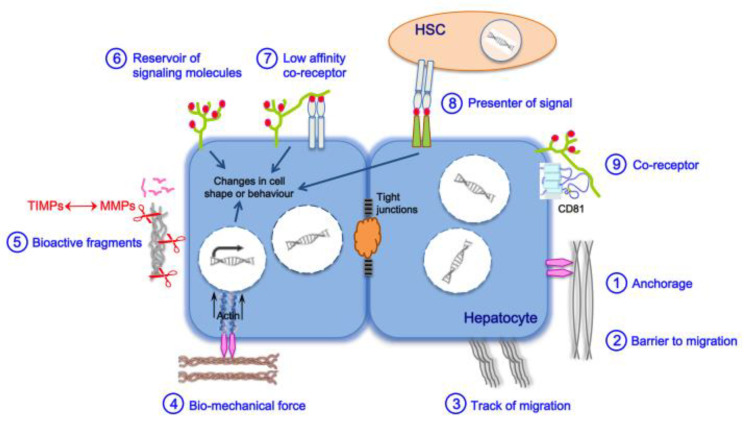Figure 1.
Mechanisms of ECM functions. Biological functions of the ECM are related to its biochemical and biomechanical properties. ① Anchorage to the basement membrane is essential for various processes, such as maintenance of polarity, cell proliferation, and differentiation. ②③ The ECM may also serve to block or guide cell migration. ④ Cells are able to sense the biomechanical properties of the ECM (e.g., stiffness), and change their shape or behavior through mechanotransduction pathways: tensional forces, focused within focal adhesion structures, induce clustering of integrin receptors, which causes recruitment of signaling proteins such as talin, vimentin, paxillin, tensin in direct connection with actin cytoskeletal filaments and microtubules. Several kinases also concentrated at the focal adhesion transfer stimuli from the ECM to intracellular signaling cascades; all these events will ultimately contribute to genome transcription and protein translation. ⑤ The ECM directs signals to the cell through bioactive fragments after their processing by proteases such as MMPs, regulated by TIMPs. ⑥ The ECM acts as a reservoir of signaling molecules by binding and by locally concentrating growth factors, cytokines, and hormones. Some ECM components such as HSPGs can selectively bind to different growth factors and function as low-affinity coreceptors ⑦ or as presenters of signals between hepatocytes and HSCs ⑧, thereby playing a major role in cell–cell communication. ⑨ We demonstrated that the HSPG syndecan-1 and the tetraspanin CD81 interact together; this interaction tightly links the ECM, the tetraspanin web, and likely the cytoskeleton and could have functional consequences on both cell behavior and ECM remodeling. Syndecan-1/CD81 form a coreceptor complex for HCV entry [31].

